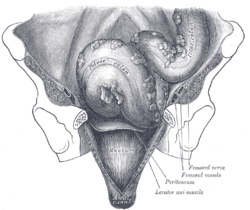Taenia coli
| Teniae coli | |
|---|---|
 Iliac colon, sigmoid or pelvic colon, and rectum seen from the front, after removal of pubic bones and bladder. (Tænia coli not labeled, but visible at center.) | |
 Female pelvis and its contents, seen from above and in front. (Taenia coli not labeled, but visible at right.) | |
| Details | |
| Identifiers | |
| Latin | Taeniae coli |
| TA | A05.7.03.013 |
| FMA | 76487 |
The teniae coli (also taeniae coli) are three separate longitudinal ribbons of smooth muscle on the outside of the ascending, transverse, descending and sigmoid colons. They are visible and can be seen just below the serosa or fibrosa. There are three teniae coli: mesocolic, free and omental taeniae coli. The teniae coli contract lengthwise to produce the haustra, the bulges in the colon.
The bands converge at the root of the vermiform appendix. At the rectosigmoid junction, the taeniae spread out and unite to form the longitudinal muscle layer. These bands correspond to the outer layer of the muscularis externa, in other portions of the digestive tract.

The teniae coli are regulated by the sacral nerves of the spinal cord, which are under control of the parasympathetic nervous system.[1]
References
- ↑ Lambert, H. Wayne; Wineski, Lawrence E. (2011). Anatomy & Embryology. Lippincott Williams & Wilkins. p. 65.
Destruction of the sacral spinal cord will eliminate parasympathetic outflow to the hindgut, pelvic organs, and perineum as well as somatic innervation to much of the pelvis and lower limbs. Because it stimulates gut motility and tone, loss of parasympathetic input will result in relaxation and inactivity of the teniæ coli in the descending colon.
External links
- Histology image: 12502loa – Histology Learning System at Boston University - "Digestive System: Alimentary Canal: colon, taeniae coli"
- UIUC Histology Subject 853
- Anatomy photo:39:13-0201 at the SUNY Downstate Medical Center - "Intestines and Pancreas: Large Intestine"
- Anatomy image:8185 at the SUNY Downstate Medical Center
